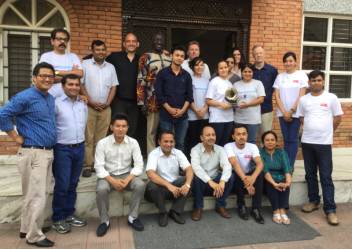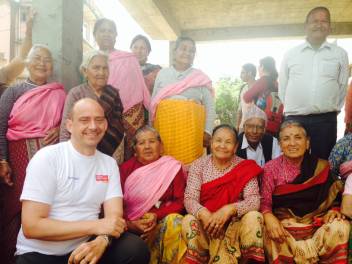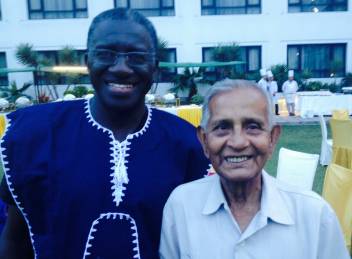 I am writing this on the flight back from Nepal to London, after a quick three day visit. It is now just over a month since the terrible earthquake that struck on 25 April. I travelled there with Sola Mahoney, a member of the HelpAge International Board of Trustees.
I am writing this on the flight back from Nepal to London, after a quick three day visit. It is now just over a month since the terrible earthquake that struck on 25 April. I travelled there with Sola Mahoney, a member of the HelpAge International Board of Trustees.
We wanted to see first-hand the situation facing older people after the disaster and to try and understand the challenges ahead.
Most of all, we wanted to thank our dedicated team of staff and partners for their amazing and courageous efforts to help those most affected by the earthquake.
Significant damage
They have been working round the clock, despite many having their own houses damaged. Some had lost friends and relatives and all have lived through an anxious month that saw a second major earthquake and almost constant aftershocks day and night. I also wanted to thank our partners around the world who came together so quickly to pledge funds for our response.
On our first day in Nepal, the team took us to a suburb of Kathmandu. The damage to this sprawling city is significant, but spread out. An estimated one in ten houses there suffered serious damage or were lost altogether. We spoke to a large group of older people, all of whom had seen their houses destroyed or seriously damaged. They were now living in tents, or staying with relatives or friends nearby.
The next day, we travelled outside to a village outside Bhaktapur and drove high into the hills above the city. This was obviously a much poorer area and more houses had been destroyed. We spoke to a large group of older people, and again heard about their experience, and their hopes and anxieties about the future.
Older people’s experiences of the earthquake
 We were invited to visit one of their houses, or what remained of it – very sad, but also inspiring to see how quickly the family had put up a temporary shelter, using the zinc roof sheets salvaged from the rubble of their houses.
We were invited to visit one of their houses, or what remained of it – very sad, but also inspiring to see how quickly the family had put up a temporary shelter, using the zinc roof sheets salvaged from the rubble of their houses.
We spoke to the 90-year-old woman living there, she told us she had been helped out of her house literally a second before it collapsed. Over Nepal, there are over 750,000 buildings completely or partially destroyed, with critical infrastructure such as bridges, hospitals and schools heavily damaged.
In both locations, all of the women and men we spoke to had received US$75 in local currency as an immediate transfer from HelpAge to help them buy some essentials for a week or two. The advantage of cash over food parcels or hygiene kits is that it puts people in charge of determining their own priorities at such a difficult time, whether it be food, medicine, shelter materials or, in one case, treating their grandchildren to their first treat at the candy store since the earthquake.
Rebuilding will take time and money
All those we spoke to were extremely happy with the distribution, and how it had been conducted. HelpAge is well on the way to completing such a payment to 10,000 families with an older person in the household, and we are very proud that we were the first agency to reach thousands of families with a cash handout.
But while we can be proud of having got this initial cash handout quickly into the hands of people who need it most, we should be under no illusion about how far it will go. It will cost hundreds of dollars for a family to buy the materials to build even a basic house in a rural area on the hillside. In towns and cities, it might cost US$10,000 or more to rebuild a destroyed house.
Huge pledges needed to respond to needs
Multiply this by the number of houses destroyed and damaged, and you can see what a challenge the population and Government of Nepal now face, and the international community supporting them. This overall picture was what we discussed with the Head of the UN in Nepal, Jamie McGoldrick.
International donors will need to pledge huge sums of money to the recovery process in Nepal, to replace the homes, schools, and health centres lost.
Yet, the UN are already warning that even in the current emergency phase, they are not seeing anything like the quantity of pledges they need.
It’s a very worrying picture, and of course the danger is that the poorest and most marginalised families, many of whom are households headed by or including older people, will be left largely to fend for themselves.
Longer-term plan to support older people
In such a resource-constrained environment, the HelpAge team and our partners in Nepal will have to advocate tirelessly and skilfully for appropriate relief and recovery programmes designed to reach and suit the older age cohort, as well as showing themselves how this can best be done.
 Sola and I left with a clearer understanding about the longer-term policy priorities in Nepal for older people. We are privileged to work with two of Nepal’s leading organisations in this area – the National Senior Citizen’s Federation, and Ageing Nepal.
Sola and I left with a clearer understanding about the longer-term policy priorities in Nepal for older people. We are privileged to work with two of Nepal’s leading organisations in this area – the National Senior Citizen’s Federation, and Ageing Nepal.
Dr Lal Das (pictured here with Sola), the wonderful 91-year-old President of the NASCIF, shared his memories of the great 1934 earthquake in Nepal, where he had narrowly avoided being killed in his school classroom.
Over the coming weeks and months, we will be working with our partners to look for opportunities to integrate our relief and recovery programmes, and our humanitarian advocacy, with our shared long-term vision for Nepal’s older population.
Find out more about our response in Nepal.
